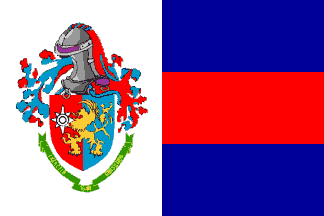 image by
Joseph
McMillan, 10 August 2005
image by
Joseph
McMillan, 10 August 2005
Last modified: 2012-01-13 by ian macdonald
Keywords: army |
Links: FOTW homepage |
search |
disclaimer and copyright |
write us |
mirrors
The command flags (insígnias de comando, chefia ou direção, literally ensigns
of command, chiefship, and directorship) of the Brazilian Army are regulated by
Ministry of the Army order [portaria] no. 793 of 4 July 1980. This order
succeeded a previous order on the same subject of 1962, which in turn followed
other directives, as is evident from the World War II
flags, which follow a similar pattern to those in use today. The 1980 order
has since been modified by order no. 370 of 16 July 1999 to take account of the
disestablishment of the service ministries and their unification under a single
minister of defense.
All command flags are 2:3 in ratio. Those of general
officers and field grade officers (majors and above) are rectangular, while
those of company grade officers are triangular. The sizes of the flags are 80 x
120 cm for hoisting on poles, 40 x 60 cm for carrying by troops, and 20 x 30 cm
for car flags.
Unfortunately, the copy of the directive on these flags
that is on line does not include the annexes spelling out the specific patterns.
However, based on examples shown, and unit command flags shown in various issues
of the Boletim Ostentiva do Exército, some of the patterns can be deduced. The
flags of general officers are divided in half vertically. The hoist half of the
flag indicates the type of organization commanded, while the fly half consists
of green and yellow stripes indicating the officer's rank (the flag of the
Commander of the Army is an exception). Other commanders of operational units
generally appear to have flags of solid color with the branch insignia on the
center, the number of the unit in the upper fly, and a sometimes a device
further defining the type of unit in the lower fly. These same emblems are also
used in the unit devices in the hoist of some of the general officers' flags.
There are presumably flags for the commanders of higher echelons of command
above brigade: the chief of the general staff (full general), commanders of
areas (full generals) and of military regions and army divisions (major
generals), but I have seen nothing on their design. If the patterns are the same
as were used in World War II, and are still used by
the Brazilian Air Force, a full general should have
four stripes alternating green and yellow and a major general, as noted above,
three. Again, the symbol of the command should go in the hoist, but I have no
information on the pattern of the background.
The directive also mentions
flags for general officers who are not commanders, chiefs, or directors, but I
have not found the pattern for these.
Sources: "Normas para a feitura de insígnias de comando, chefia
ou direção," Portaria Ministerial nš 793 de 4 de julho de 1980, as amended by
Portaria nš 370, de 16 de julho de 1999, cited at
http://www.cdocex.eb.mil.br/insignias.htm (website of Centro de Documentação
do Exército).
Note: The "Normas para a feitura" document is linked from the
CdocEx page, but as it is a Word document, it is not a good idea to follow the
link. Those who wish to see this document should google for it and use the
Google-provided HTML version.
Joseph McMillan, 10 August 2005
 image by
Joseph
McMillan, 10 August 2005
image by
Joseph
McMillan, 10 August 2005
The flag of the Commander of the Army is shown in the 1999 order. The flag is
white in the hoist with the arms of the Brazilian Army in full color (these are
the same arms shown on the Army standard). The fly
consists of three horizontal stripes, blue-red-blue, the same as were in the
flag of the Minister of the Army, the position that
was abolished in 1999 and replaced by that of Commander of the Army. The
directive specifies both the blue in the arms and that in the stripes as "azul-celeste,"
or sky blue, but the images on the Brazilian Army site clearly show the stripes
darker.
Joseph
McMillan, 10 August 2005
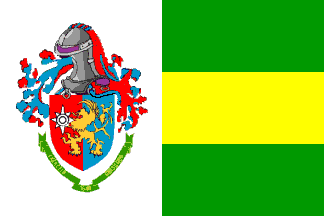 image by
Joseph
McMillan, 10 August 2005
image by
Joseph
McMillan, 10 August 2005
The flag of the Chief of the Office (chefe do gabinete) of the Commander has
the same design in the hoist but stripes of green and yellow in the fly
consistent with the rank of the officer holding the position, three stripes for
a major general (general de divisão) or two if the incumbent is a brigadier
general (general de brigada).
Joseph
McMillan, 10 August 2005
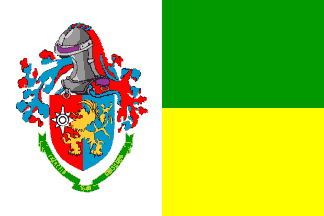 image by
Joseph
McMillan, 10 August 2005
image by
Joseph
McMillan, 10 August 2005
The flag of the Chief of the Office (chefe do gabinete) of the Commander has
the same design in the hoist but stripes of green and yellow in the fly
consistent with the rank of the officer holding the position, three stripes for
a major general (general de divisão) or two if the incumbent is a brigadier
general (general de brigada).
Joseph
McMillan, 10 August 2005
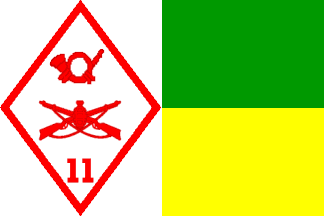 image by
Joseph
McMillan, 10 August 2005
image by
Joseph
McMillan, 10 August 2005
Brigade commanders fly flags that are white in the hoist with the symbol of
the brigade in red surrounded by a hollow red lozenge. The symbol usually
consists of the insignia of the army branch to which the brigade belongs
(crossed rifles and hand grenade for infantry, crossed lances for cavalry, bomb
for artillery, castle for engineers, etc.) with the number of the brigade at the
bottom. The fly is divided green over yellow to denote the commander's rank as
brigadier general.
Joseph
McMillan, 10 August 2005
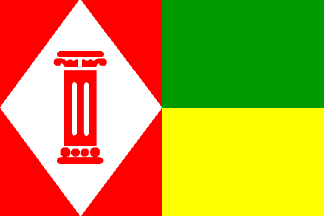 image by
Joseph
McMillan, 10 August 2005
image by
Joseph
McMillan, 10 August 2005
Directors of directorates in the Army headquarters have flags with a red
hoist and the device of their directorate in red centered on a white lozenge.
The example attached is the flag of the Director of Personnel Support, with a
red column. Again, the fly is striped to indicate the rank of the incumbent.
Joseph
McMillan, 10 August 2005
 image by
Joseph
McMillan, 10 August 2005
image by
Joseph
McMillan, 10 August 2005
The available examples for the flags of chiefs of army centers have the
organizational emblem in the hoist in red on the middle of a white rectangle
bordered in red. The fly is blue with two red stripes near the top and bottom.
The example is the flag of the Center for Army Documentation (which, among other
things, is responsible for army heraldry including these flags), a scroll
surmounted by a cross of the Order of Christ and an armillary sphere. In some
cases the initials of the center are inscribed in red below the emblem..
Joseph
McMillan, 10 August 2005
The commander of an army had the number of the army in Roman numerals, and three green and two yellow
stripes. The
illustration is the command flag for the 3rd Army, traditionally the most
important,
posted in southern Brazil near the Argentine, Paraguayan, and
Uruguayan
borders.
Joseph McMillan, 2 May 2001
Commander of the artillery of an army: a flaming grenade above the
number of the army in Roman numerals; in the fly, three green and two yellow stripes.
Joseph McMillan, May 2001
Commander of an army corps: the number of the corps in Arabic
numerals; in the fly, two green and two yellow stripes.
Joseph McMillan, 3 May 2001
Commander of corps artillery: a flaming grenade above the number of
the corps in Arabic numerals; in the fly, two green and two yellow stripes.
Joseph McMillan, 3 May 2001
Commander of a cavalry corps: crossed lances with pennons above the
number
of the corps in Arabic numerals; in the fly, two green and two yellow stripes.
Joseph McMillan, 3 May 2001
Commander of an infantry division: the number of the division in
Arabic
numerals; in the fly, two green and one yellow stripe.
Joseph McMillan, 3 May 2001